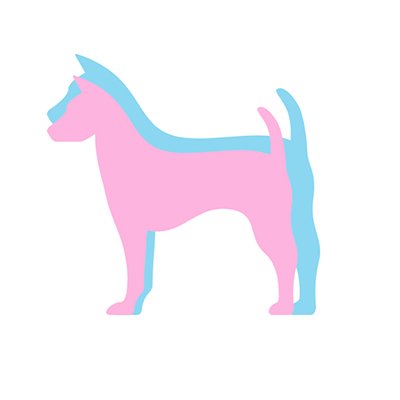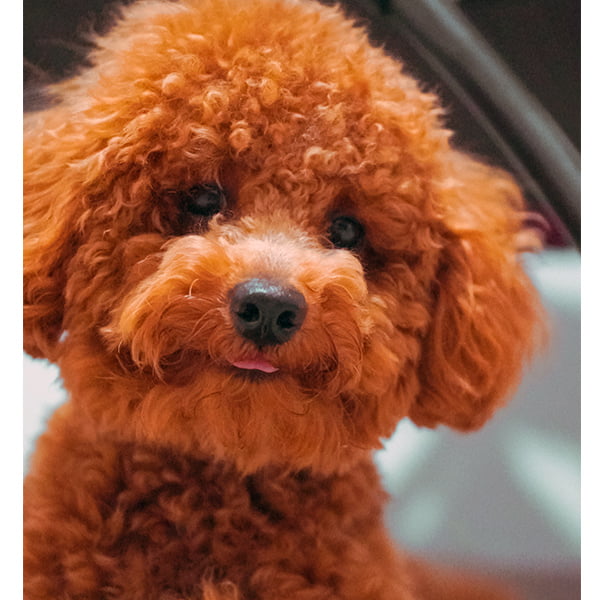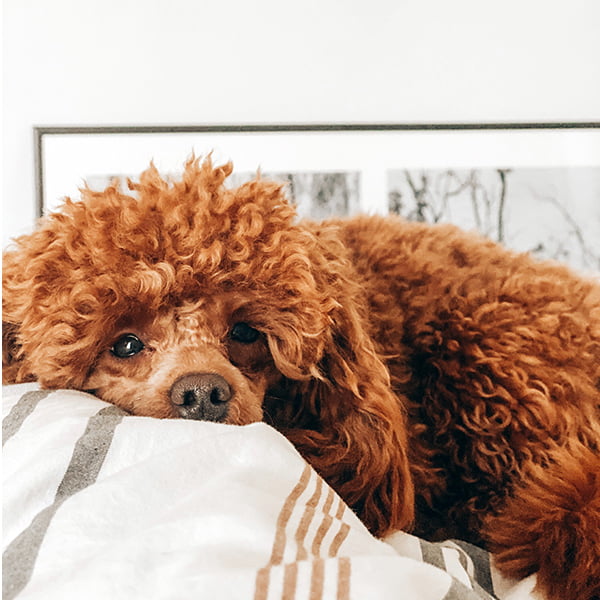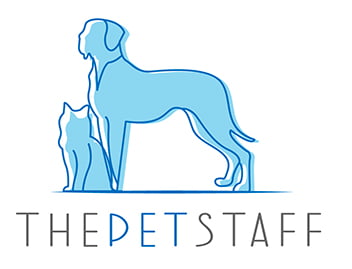Moyen Poodle, also known as Klein Poodle, French Poodle, Chien Canne, or Canniche, is a medium size Poodle. They are between Standard Poodles and Miniature Poodles. This breed has been popular across Europe for a long time, and it's for good reasons too.
The classic curly coat and fluffy Moyen Poodle are irresistibly cute. Smart, cuddly and hardy, Moyen Poodles has all the lovable qualities of a Poodle that make the breed so popular. They make great family dogs and are used as service or therapy dogs, and they are also great small apartment living and even recreational vehicle living breeds.
So, is the Moyen Poodle for you?
Breed Characteristics
Temperament | Intelligent, Alert, Active, Faithful |
Intelligence | High |
Affection/Friendliness | High |
Trainability | High |
Mental Stimulation | Moderate |
Exercise Needs | Moderate |
Apartment Living | Suitable |
Family Friendly | Yes |
Pet Friendly | Yes |
Drooling Level | Low |
Energy Level | Medium |
Loneliness Tolerance | Low |
Adaptability | High |
Tendency to bark | Moderate |
Origin of Moyen Poodles
The origin of the Moyen Poodle is not known exactly. They would have begun to be seen around the same time that poodles became popular pets for French royalty, but the exact date is unknown. Poodles have a long history, beginning in Germany somewhere in the 14th century as hunting retrievers and water dogs. Moyen Poodles are often called Klein Poodles in Germany.
The word "poodle" comes from the German word "puddeln," which is the German word that means "splashing in the water." By the end of the 15th century, the breed had come to France, where they became the favored pets of royalty. Their popularity only grew from there, and they have since spread worldwide to become one of the most popular dog breeds in the world.
"Moyen" comes from the French word for medium, and that is what a Moyen Poodle is, a medium-sized poodle, something between a Standard size poodle and a miniature poodle.
Moyen Poodles are purebred poodles that come from breeding a miniature and Standard Poodle or by breeding two Moyen Poodles. A breeder should never breed a standard Poodle with Miniature Poodle to get Moyen Poodle puppies, as they will develop structural problems.
The Moyen Poodle size is not recognized by any of the major kennel clubs, including the AKC (American Kennel Club), the KC (Kennel Club), the CKC (Canadian Kennel Club), or the UKC (United Kennel Club). However, they are recognized as purebred poodles and can be registered. They can compete in performance sports like agility or tracking but cannot compete for showing since they do not meet the size requirements of the three recognized poodle sizes.

Breed Overview
Height: 15-20"
Weight: 20-35 lbs
Height: 15-20"
Weight: 15-35 lbs
Breed Group
Non-Sporting
Life Span
12-15 years
Coat
Curly
Coat Length
Medium
Hypoallergenic
Yes
Shedding Level
Low
Size
Moyen Poodle weight for an adult is between 15 and 35 pounds and reaches heights between 15 and 20 inches, making them a medium size dog breed.
Personality
Moyen poodles have all the same personality traits as Standard Poodles. They are smart, lovable, friendly, active, loyal, and fun-loving. These winning personalities are part of what makes them such beloved and versatile pets. They are obedient, well-mannered, and social, margin them easy to bring along into your daily life.
Appearance/Colors
Moyen Poodles have a single-layer coat of dense, curly hair. This hair can come in a number of colors, including black, white, grey, silver, blue, brown, cream, apricot, and red. They are of medium height and carry themselves very much like full-sized Poodle. They have long faces, floppy ears, and dark eyes.
Temperament
The Moyen Poodle temperament mixed with the medium poodle size makes Moyen Poodles a great pet choice for almost anyone. They are cuddly, friendly, and lovable but energetic enough to keep you busy without being high maintenance. They make great family dogs or dogs for seniors. They excel in service and as therapy dogs, and their hypoallergenic coat means they can be a good choice for dog lovers who may have a dog allergy.

Image source: Unsplash
Diet/Nutritional Needs
Moyen Poodles have normal dietary needs and need quality dog food fed in measured portions twice a day. The amount of food will depend largely on your dog's age, size, activity level, and general health. Your vet can help you determine the best type of food and quantity for your Poodle. Treats and table scraps should be kept to a minimum to prevent obesity.
Activity/Exercise Needs
The Moyen poodle's exercise needs are moderate. They will need daily activities of some sort but love variety and will enjoy keeping up with their people.
Moyen enjoys walks, hiking, jogging, water sports, dog sports like tracking or agility, trick training, and more. Moyen Poodles will thrive in homes with a big backyard and will love dog parks if they are properly trained and socialized.
As an intelligent breed, Moyen Poodles will also need mental stimulation to stay happy and healthy. Games like fetch and hide and seek work great, and puzzle toys can keep them entertained for hours.
Grooming Needs
You may wonder are Moyen Poodles Moyen poodles hypoallergenic? Like all poodles, they have a very low shed coat, making them hypoallergenic and pretty easy to groom. They are a great dog breed for people with pet allergies.
Moyen Poodle should still be brushed several times a week, especially if they have longer coats, but this is just to prevent tangling and mats. They can be groomed and clipped in much shorter hairstyles which can cut down on the amount of time you have to brush them, but they will have to be clipped more often to keep them looking smart.
Nails should be kept trimmed short, and you should periodically examine their ears to check for debris, irritation, or infection.
Adaptability
Due to their size, these dogs can fit almost any lifestyle easily. They make great apartment dogs, though they can be moderate barkers which could annoy neighbors. They are adaptable in all kinds of climates, though care should be taken in colder seasons if you keep your Poodle's coat clipped short.
Like most dogs, Moyen Poodle does not do well when left for long periods on their own and can become destructive or anxious. Try not to leave your dog for long amounts of time, and supply puzzle toys to keep their minds occupied while you are away.
Moyen Poodles are great with kids and can be taught to get along well with other dog breeds and pets. Some will say they are the most obedient and smartest dogs with playful enthusiasm and adventurous spirit, making them a great addition to any family.
Trainability of Moyen Poodle Puppies
Because they are smart and love to please their owners, a Moyen puppy is quite easy to train. They can sometimes be a bit prone to stubbornness and are quite sensitive, so positive reinforcement is a must.
They can be trained throughout their lives as they can excel in sports like agility, tracking, retrieval, and obedience. They are easily distracted, so you must be patient and keep training sessions short while your Moyen poodle is a puppy. Training Moyen Poodles and socialization should start early with your Moyen Poodle puppy to ensure that it adjusts quickly and learns how to behave in public and social settings.
Life Expectancy
A relatively healthy Moyen poodle will have a life expectancy of 12-15 years.
Cost
Depending on the breeder, Moyen Poodles cost, on average, $2000. If you are considering using a breeder, do your research and go with reputable breeders. A breeder should never breed a Toy Poodle with a Standard Poodle to produce a medium-sized Moyen Poodle, as the offering may have serious structural problems.
If possible, check out the shelter or rescue groups first.

Image source: Unsplash
Potential Health Issues
Picking the right breeders can be the difference between a healthy Moyen Poodle or a poodle who will be riddled with hereditary conditions. The healthiest Moyen Poodles come from European poodles. This is because this medium size has a much longer history in Europe, where they have been intentionally breeding Moyen Poodles for the best possible health and temperament.
Hip Dysplasia
This is a heredity condition that results in the malformation of a poodle's joints that can begin as early as puppyhood.
Eye Disorders
A few of the most common eye disorders seen in Moyen Poodles include—
Glaucoma
This is caused by insufficient fluid drainage in the eye, which can progress very quickly. It can often lead to the optical nerve and retinal damage and the dog losing its vision.
Progressive Retinal Atrophy (PRA)
This is a degenerative disease that affects photoreceptor cells. With this disease, the cell will deteriorate over time and lead to blindness.
Tear Staining
Tear stains can be a result of excessive tear production. Tear stains are common, but some dogs produce too many tears or have the inability for tears to drain properly.
Optic Nerve Hypoplasia
This condition affects the optic nerves and leads to a variable degree of vision reduction or blindness.
Cataracts
This is when the lens of the eye becomes cloudy, which is caused by the changes in water balance in the lens or protein within the lens. When the lens becomes cloudy, the light can't reach the retina and cause blindness in the dog.
Von Willebrand's Disease
This bleeding disease affects the blood's ability to clot properly. The condition can be managed, but it is a lifelong condition.
Luxating Patella
A luxated patella is where the knee cap dislocates out of its normal position and becomes misaligned. Conservative medicine to surgery is available, depending on the grade of the disease.
Bloat
This is a condition where gas builds up in the stomach, causing it to twist out of shape and keep any food from entering or leaving the stomach. To prevent this, give your dog small portion meals, a slow feeder, or an automatic feeder to feed small meals throughout the day.
